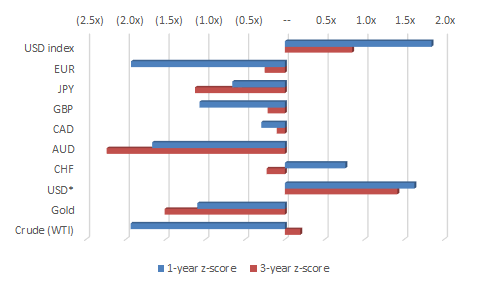Looking at this week’s Commitments of Traders Report, there are several changes in speculator positioning across major currencies and commodities. Specifically, speculators increased their bullish positions in the Japanese yen, the British pound and gold. On the other hand, Swiss franc net positions fell this week after rising for seven weeks in a row.
The Japanese yen has been making gains recently thanks to deteriorating risk sentiment. As a safe haven currency, the yen tends to strengthen in response to weakness in ‘risk on’ assets such as equities and commodities. Following positive headlines relating to Brexit discussions, speculators are also warming up to the British pound. The caveat is that the negotiation process is volatile, and the outcome from trade negotiations remains unclear. Finally, speculators added to their net short positions in the Swiss franc this week. After strengthening decisively against the dollar starting in late August, the franc has weakened for the last four weeks in a row.
Turning to extremes in positioning, only short Australian dollar net positions are at an extreme this week. Last week, short gold positions were at a bearish extreme, but this is no longer the case today. When the net speculator position is more than two standard deviations smaller or larger than the trailing 12-month or 36-month average, we flag the position as an extreme.
The purpose of this weekly report is to track how the speculator community is positioned across various major currencies and commodities. When net long positions become crowded in either direction, we flag extended positioning as a risk. Crowded positions do not suggest an imminent reversal, but should be considered as a significant risk factor when investing in the same direction as the crowd. This is shown below:
CFTC COT speculator positions (futures & options combined) – October 16, 2018

Source: CFTC, MarketsNow
Notable extremes, significant changes in weekly positions, and large net positions as a proportion of open interest are highlighted in gray above. Extremes in net positions are highlighted when speculator positioning is more than two standard deviations above trailing 1-year and 3-year averages. Weekly changes are highlighted when they are significant as a proportion of open interest. Finally, net positions as a proportion of outstanding interest are highlighted when they are large relative to historical averages. 1-year and 3-year z-scores are visually represented below:
1-year and 3-year z-scores based on net speculator positions

Source: CFTC, MarketsNow
Last week, our analysis of the COT Report assessed the increase in bearish bets against gold. At the time, the net position in gold had fallen to 56,998 futures and options contracts net short. This week, speculators have increased their bets on gold by a total of 71,957 contracts, bringing the net position into positive territory (i.e. speculators are now net long) for the first time in 10 weeks.
After gold net short positions fell into record territory last week, the precious metal rallied as short positioning became crowded. Sharp reversals are typical when the consensus (i.e. all of Wall Street) is caught on the same side of any trade. In trading terminology, last week’s price action in gold was most likely a ‘short squeeze’.
Specifically, gold moved up sharply on October 11 – a rally that was matched by increasing trading volumes in gold futures. The combination of a big move in price and accelerating volumes is a positive signal for the precious metal. Following the move, we have upgraded our outlook on gold to neutral accordingly.
While the outlook for gold is increasingly positive, the precious metal remains weighed down by US Treasury bond yields which remain elevated, and continued strength in the US dollar. For gold to break out into a bullish trend, either bond yields or the dollar have to weaken.
Any opinions, news, research, analyses, prices or other information contained on this website is provided as general market commentary and does not constitute investment advice. MarketsNow will not accept liability for any loss or damage including, without limitation, to any loss of profit which may arise directly or indirectly from use of or reliance on such information.
Recommended Content
Editors’ Picks
EUR/USD holds above 1.0700 ahead of key US data

EUR/USD trades in a tight range above 1.0700 in the early European session on Friday. The US Dollar struggles to gather strength ahead of key PCE Price Index data, the Fed's preferred gauge of inflation, and helps the pair hold its ground.
USD/JPY stays above 156.00 after BoJ Governor Ueda's comments

USD/JPY holds above 156.00 after surging above this level with the initial reaction to the Bank of Japan's decision to leave the policy settings unchanged. BoJ Governor said weak Yen was not impacting prices but added that they will watch FX developments closely.
Gold price oscillates in a range as the focus remains glued to the US PCE Price Index

Gold price struggles to attract any meaningful buyers amid the emergence of fresh USD buying. Bets that the Fed will keep rates higher for longer amid sticky inflation help revive the USD demand.
Sei Price Prediction: SEI is in the zone of interest after a 10% leap

Sei price has been in recovery mode for almost ten days now, following a fall of almost 65% beginning in mid-March. While the SEI bulls continue to show strength, the uptrend could prove premature as massive bearish sentiment hovers above the altcoin’s price.
US core PCE inflation set to signal firm price pressures as markets delay Federal Reserve rate cut bets

The core PCE Price Index, which excludes volatile food and energy prices, is seen as the more influential measure of inflation in terms of Fed positioning. The index is forecast to rise 0.3% on a monthly basis in March, matching February’s increase.